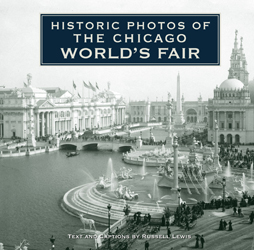Russell Lewis, the executive vice president and chief historian at the Chicago History Museum, prefaces Historic Photos of the Chicago World’s Fair by noting that “[t]he World’s Columbian Exposition of 1893 was the most photographed event in the nineteenth century.” Many of the photos shot at Chicago’s great South Side fair ended up…
 |
Russell Lewis, the executive vice president and chief historian at the Chicago History Museum, prefaces Historic Photos of the Chicago World’s Fair by noting that “[t]he World’s Columbian Exposition of 1893 was the most photographed event in the nineteenth century.” Many of the photos shot at Chicago’s great South Side fair ended up at the museum, and Lewis has used about 200 of them to resurrect Daniel Burnham’s White City between the covers of this recently published book. It’s a splendid collection, introduced by a useful map of the fair and a detailed bird’s-eye overview that helps orient readers as they wander through the black-and-white images of the huge pale palaces, the colorful ethnic villages, and the raucous Midway with its 262-foot-tall Ferris wheel (shown in photos shot from several different perspectives).
The most dramatic images are the before and after photos. Lewis reveals the fair as it appeared while under construction, with workers—who moved more than 1.2 million cubic yards of earth—carving the lagoons and landscaped grounds out of the marshes and prairies around Jackson Park. He shows the buildings as they were going up, their unadorned steel skeletons more breathtaking than after they were draped in a faux plaster (called “staff”) and classical façades. (The unadorned Manufacturers and Liberal Arts Building—at 1.3 million square feet, the largest roofed building ever constructed up to that time—is especially impressive.) And though the Columbian Exposition was never built to last—the Museum of Science and Industry, originally the Fine Arts Building, is the fair’s only surviving structure—it’s still sad to see photos of the fair in ruins after a series of fires, an ignoble end to a grand if transitory event that lured more than 21,000,000 awed visitors to Chicago.
• One of those visitors was the historian Henry Adams, and Lewis’s book helped me more clearly envision that crucial moment in Adams’s life. The grandson and great-grandson of two U.S. presidents (John and John Quincy Adams) and the author of a multivolume history of the United States during the administrations of Jefferson and Madison, Adams was a man deeply rooted in the country’s earliest years. His Mont Saint Michel and Chartres, about the great cathedrals of Europe, carried his sensibilities back another five or six centuries. Left dumbstruck by the powerful energy-generating dynamos exhibited at the Columbian Exposition, Adams plopped down on the stairs beneath the dome of the fair’s Administration Building to ponder a future he had never imagined. Adams described that epiphany (albeit in the third person) in The Autobiography of Henry Adams, chosen by the Modern Library as the best nonfiction book of the 20th century. You can read the chapter entitled “Chicago (1893)” at the University of Virginia’s website.
• One picture in Lewis’s collection shows an October 1892 parade down State Street that preceded the official dedication of the fair. Towering over the city’s quaint Victorian structures is one of the first great skyscrapers, Burnham and Root’s Masonic Temple, then the tallest building in the world. Here at the northeast corner of State and Randolph was the real future of architecture, as opposed to the studied neoclassicism of the Columbian Exposition. You can read more about the building (which was demolished in 1939) and Burnham’s brilliant partner John Root (originally slated to help co-plan the fair before his sudden death at age 41) in my 1987 article for the Chicago Reader.
Photographs: Courtesy Turner Publishing Company


